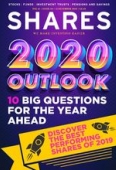Archived article
Please note that tax, investment, pension and ISA rules can change and the information and any views contained in this article may now be inaccurate.
Follow these golden rules when searching for income

Investors continue to face obstacles in the search for income. In the past week alone, oil producer Tullow Oil (TLW) has suspended its dividend and troubled investment trust Hadrian’s Wall (HWSL) says its future dividend payments will depend on its ability to realise value from its portfolio.
Vodafone (VOD), Centrica (CNA), Royal Mail (RMG) and Marks & Spencer (MKS) have cut their dividends this year and BT (BT.A) may well be the next to follow suit.
Among savings accounts, fixed term bond rates have fallen throughout 2019 and are now at their lowest levels since 2017, according to research group Moneyfacts which also says one-year fixed-term ISA rates have been in decline this year.
Low rates on cash accounts and dividend setbacks among large cap stocks have driven investors to look elsewhere for better returns. Unfortunately there is a danger they venture into high-risk areas of the market – particularly high-yield funds – without fully understanding how higher sources of income are generated.
HIGH YIELD CHOICES
There are currently 64 open-ended funds and 128 investment trusts and venture capital trusts yielding 5% or more.
Many of these products generate a return greater than the market – for way of comparison, the FTSE All-Share yields 4.4% – by investing in higher-risk areas including aircraft leasing, emerging market debt, small business lending and retail property.
Anyone reliant on their investments to generate income to help pay the bills would need to be comfortable owning funds with such exposure. They would need to accept that higher risks must generally be taken to obtain higher yields.
GOLDEN RULES
There are a few simple rules to follow if you are investing for income. First, be diversified – make sure you aren’t reliant on a single or handful of stocks for dividends.
People often refer to funds as offering instant diversification but this isn’t true for all of them. Some funds have a very concentrated portfolio of assets and when something goes wrong with one of their holdings, it can have a very bad effect on the whole product. So just remember to check the fact sheet to fully understand what’s inside the fund.
The second rule is to understand how the income is generated and the risks involved. With shares, check to see if a high yield is the result of a falling share price as that is often a warning sign of troubles to come.
The third rule is not selecting a fund or stock purely based on its dividend payment frequency.Finally don’t forget to consider total return – taking into account dividends AND changes to the value of your shares or funds. After all, what’s the point in investing in something that is generating good income if the value of your capital is being eroded?
Important information:
These articles are provided by Shares magazine which is published by AJ Bell Media, a part of AJ Bell. Shares is not written by AJ Bell.
Shares is provided for your general information and use and is not a personal recommendation to invest. It is not intended to be relied upon by you in making or not making any investment decisions. The investments referred to in these articles will not be suitable for all investors. If in doubt please seek appropriate independent financial advice.
Investors acting on the information in these articles do so at their own risk and AJ Bell Media and its staff do not accept liability for losses suffered by investors as a result of their investment decisions.

 magazine
magazine









